The ability to sting, coupled with their great mobility, makes bees and wasps some of the most feared of all insects. Many species of bees and wasps are present in every geographic region of Missouri. These species vary in aggressiveness and other behaviors, however, and only a few need to be feared. Knowledge of their habits is the first step in reducing fear to a level of healthy respect and in deciding how to manage their presence around the home.
Some bees and wasps do not possess stingers. In groups that can sting, only females have stingers because a stinger is a modified egg-laying structure. Wasps and some bees sting repeatedly because their stingers are smooth. A honey bee stings only once because it has a barbed stinger that remains embedded in the victim's skin. The honey bee's stinger is attached to a venom sac, which has muscles that pump venom into the victim. The bee dies after this one sting. Because some people are very sensitive to the venom of bees and wasps, stings cause several human deaths in the United States each year.
A person sensitive to bee stings is not also automatically sensitive to wasp stings or vice versa. Likewise, a person who is sensitive to one kind of bee sting is often sensitive to only that kind of bee, not all bees. However, a person sensitive to one kind of wasp will often be sensitive to other kinds of wasps.
Bee and wasp stings
A bee or wasp sting results in local pain, swelling, redness and itching for most persons. To minimize the symptoms, apply a poultice of meat tenderizer or salt to the site as soon as possible after the incident, and leave it on for about 30 minutes. Use about half a teaspoon mixed with enough water to produce a paste. Commercial sting-swabs that do about the same thing are also available.
Some people may react violently if they are stung. Symptoms can include difficulty in breathing, dizziness and nausea, as well as the more common symptoms listed above. With severe reactions, medical attention is needed. Anyone with a history of hypersensitive reactions should have a sting emergency kit available and should wear a medical alert bracelet or other alert item. Consult your physician about desensitization treatments.
Bees
Honey bees
Honey bees (Apis mellifera) are about 0.5 inch long with a fuzzy light brown to black appearance and a brown-and-black-striped abdomen (Figure 1). They are considered to be the most beneficial species of insect because they pollinate plants and produce honey and beeswax. However, because they sting in defense of their nest, honey bees may become a pest if nests are inside a building wall.
Wild colonies of honey bees nest in existing cavities, such as hollow trees. Domestic bees are housed in manufactured hives. A honey bee colony occupies the same nest from year to year. A queen and many workers survive the winter inside the nest. At various times during the year, new queens are produced and the old queen leaves the nest with a few thousand workers to "swarm." Swarming is the process of searching for a new home. The risk of being stung is lower around a swarm because swarming is a period of vulnerability and the colony has no hive or honey to protect.
If a swarm settles in a place where bees are not welcome, such as the wall of a house, then they become pests. Ideally, honey bee swarms should be picked up before they start to establish a nest in an undesirable location. Some beekeepers will capture and remove swarms. Police departments and extension offices can direct you to local beekeepers. Once a swarm establishes a nest inside a wall, the bees and the comb must be removed. The damage should be repaired to prevent another swarm attempting to establish their colony in the same location. Some professional pest control operators provide this service for a fee.
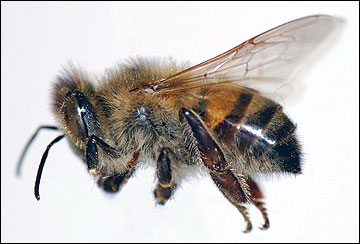 Figure 1
Figure 1
Honey bee; about 0.5 inch long.
Bumble bees
Bumble bees of the genus Bombus are robust and densely covered with black and yellow hairs called setae, the pattern of colors varying with species (Figure 2). They range in size from about 0.5 to 1 inch long. Bumble bees are social and nest in existing cavities, usually on or in the ground. They often use abandoned mouse or bird nests but will nest in anything containing cotton or other soft materials. Only fertilized queens survive the winter.
Bumble bees are beneficial pollinators. They are social insects whose worker bees visit many different kinds of plants to collect pollen and nectar. Some farmers and gardeners encourage bumble bee activity by putting out hollow nesting boxes near their crops. Bumble bees seldom enter structures and do not behave very aggressively except in defense of their nest. Normally they are a nuisance only if they have built a nest close to human activity.
If control is necessary, it should be done by spraying or injecting a dust insecticide into the nest. DeltaDust (deltamethrin) or various liquid or aerosol pyrethroids are effective (Table 1). Apply the insecticide after dark, using a flashlight with a red lens or a lens covered with red cellophane. Bees and wasps cannot see red, so they will not be attracted to the light, but the operator will be able to see well enough to apply the pesticide.
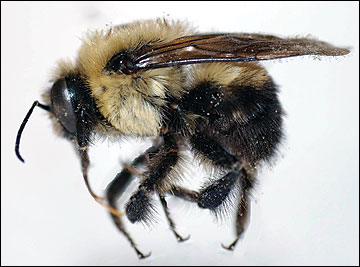 Figure 2
Figure 2
Bumble bee; about 0.75 inch long.
Other bees
Sweat bees, mining bees, leaf-cutting bees and others make up a rather large group of small-bodied (up to 0.5 inch long) solitary bees common in most areas of Missouri. Most of these bees nest in the soil, and often a large number of them will nest close together, usually in areas with sparse vegetation. Occasionally, some may nest in natural cavities in wood.
Sweat bees get their name from an attraction to people who are perspiring. They rarely sting except when pinned against the skin. Some species of mining bees may be attracted in large numbers to swimming pools.
All of these bees are beneficial because they pollinate plants. Controlling them is not desirable, even if it were easy to do so. When large numbers invade swimming pools, control may be needed and you can then treat the soil nests with any of the insecticides listed in Table 1. However, finding the nesting site is usually difficult because these bees may fly long distances.
Wasps
Yellowjackets
Two yellowjacket species occur throughout Missouri: the eastern yellowjacket (Vespula maculifrons) and the southern yellowjacket (Vespula squamosa). A third species called the German yellowjacket (Vespula germanica) is common in the St. Louis area.
Yellowjackets are named after their yellow-and-black-striped body markings (Figure 3). Worker yellowjackets are about 0.5 inch long. Their nests consist of multilayered combs surrounded by a paper shell. The eastern yellowjacket and the southern yellowjacket usually build their nests in underground holes and only occasionally in aboveground cavities (Figure 4). The German yellowjacket almost always nests in aboveground cavities. A large nest is usually about the size of a basketball. In late summer, nests may contain up to 5,000 workers.
In late summer, colonies reach their maximum size and then produce a group of new queens and males. After mating, these new queens go into hibernation. The queens that survive the winter start new colonies the next spring. The rest of the colony does not survive the winter. Old nests are not reused.
All yellowjackets aggressively defend their nests and will be most aggressive in late summer and fall. Because yellowjackets forage for meats, sweets, ripe fruit and garbage, they pose a threat to humans even when they are not near their nests. They are usually a problem in picnic areas and orchards and around garbage containers.
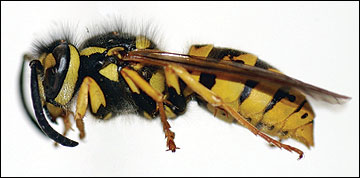 Figure 3
Figure 3
Yellowjacket wasp; about 0.5 inch long.
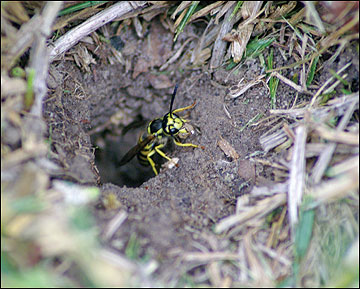 Figure 4
Figure 4
Yellowjacket nest entrance.
Managing yellowjackets
Good sanitation practices are essential to manage yellowjacket populations because they are scavenging insects that feed on a wide variety of food sources. All food garbage and empty beverage cans should be placed in containers with tight-fitting lids.
If you have a problem with a large number of foraging yellowjackets, traps offer some control. You can make one such trap by suspending a dead fish from a tripod above a water-filled tub with a few drops of liquid dish soap or other wetting agent. The odor of the fish attracts foraging yellowjackets. The yellowjackets often will cut away a piece that is too heavy to carry and fall into the water. The wetting agent prevents them from floating, so they drown.
Yellowjackets in underground nests can be killed by pouring about a quart of liquid insecticide into the entrance hole or by placing about half a cup of an insecticide dust into the hole. Several effective insecticides labeled for wasp control are available over the counter to the homeowner. Typically these are pyrethroid compounds (Table 1).
Locate the nest during daylight, and treat it after dark when all of the insects are in the nest. The underground nests may have more than one entrance. If the ground is relatively smooth and soft around an entrance, placing a heavy object over the entrance hole after treating will help ensure control. Use a red-lensed flashlight during the treatment at night, as described under bumble bees.
Baldfaced hornets
The baldfaced hornet (Dolichovespula maculata) is about 0.7 inch long and is black with whitish markings (Figure 5). It builds a distinctive pear-shaped, basketball-sized nest covered with grayish paperlike material (Figure 6). It usually constructs this nest in a tree or shrub or under the eave of a building.
Baldfaced hornets are beneficial because they capture other insects as prey to feed their larvae. As they usually do not threaten humans, it is best to leave them alone. If it is necessary to destroy a nest because of the threat of stings, spray after dark with a pressurized spray stream directed into the nest opening, which is usually near the bottom. Scout the nest during daylight to locate the opening and use a red-lensed flashlight when treating at night. Use any of several commercial bee-and-wasp sprays or a product with a similar name. Special products designed to shoot a stream of liquid more than 20 feet are best. Preferably, use a formulation that quickly kills wasps on contact (Table 1). These quick-knockdown products are often called wasp "freeze."
Some people have tried to remove these nests by suddenly covering them with a plastic trash bag, tying it tightly to the branch, and then sawing the branch off. Don't do it! Baldfaced hornets can escape from a trash bag with ease.
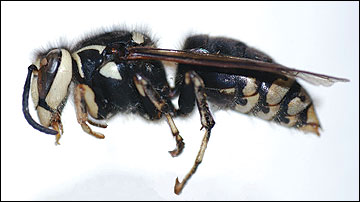 Figure 5
Figure 5
Baldfaced hornet; about 0.75 inch long.
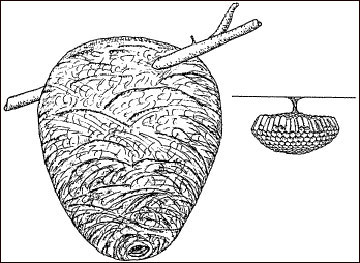 Figure 6
Figure 6
Bald-faced hornet nest (left) and paper wasp nest (right).
European hornets
The European hornet (Vespa crabro) occurs across southern Missouri roughly south of Interstate Highway 44. It is dark brown with yellow and reddish markings and is about 1.2 inches long (Figure 7). It usually nests in a hollow tree or log, or within buildings. The nest is covered with a brown envelope of coarse wood fibers. Although it causes alarm because it is a large wasp and comes to lights at night, this wasp is actually not very aggressive.
The European hornet preys on other insects and could be left alone unless the nest is located near human activity. If control is necessary, follow the same guidelines as for the baldfaced hornet.
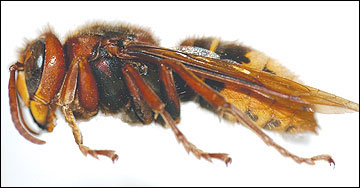 Figure 7
Figure 7
European hornet; about 1.25 inch long.
Paper wasps
Several species of paper wasps of the genus Polistes occur in Missouri. All are about 0.7 to 1.0 inch long, slender and variously colored with brown, red and yellow (Figure 8). They build their single-comb unprotected nest from the eaves or porches of buildings or other sheltered locations (Figure 6). As with all the other wasps, only the queen survives the winter to start new colonies in the spring.
Paper wasps are not as aggressive as yellowjackets or hornets in defense of their nest. These nests should be eliminated only if they are located near human activity and pose a risk of stings. To eliminate a nest, spray with a pressurized spray stream as described for the baldfaced hornet. Return a few hours later and remove the nest to discourage other paper wasps from nesting there.
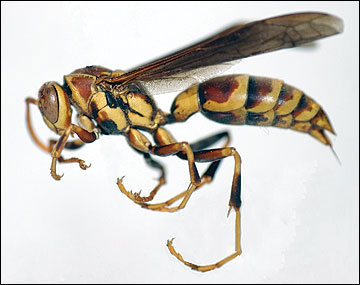 Figure 8
Figure 8
Paper wasp; about 1 inch long.
Mud dauber wasps
Mud daubers are solitary wasps of the family Sphecidae. They vary in length from 0.5 to 1.25 inches and are very slender with threadlike waists (Figure 9). They build mud nests in sheltered areas. These nests are tubelike cells often positioned side by side (Figure 10).
The female wasp stocks the nest with insects or spiders that she has captured and stung into paralysis. After laying an egg on the prey, she builds a partition to make a small cell. Then she captures another prey, lays another egg and builds another wall to make the next cell, continuing until the tube is full of individual cells containing prey and eggs.
Mud daubers overwinter as larvae in the mud tubes. One of Missouri's most common species is the black-and-yellow Sceliphron caementarium. A related common species, Chalybion californicum, is metallic blue with bluish wings. It steals the nests of S. caementarium, replacing nest contents with its own spiders and eggs.
Mud daubers are not aggressive, don't defend their nests, and usually sting only when pinned against the skin. They are beneficial except for their unsightly mud nests, which often are placed around human habitation. Undesirable nests should be knocked down and the residual soil washed off with water and a brush. No insecticide treatments are necessary.
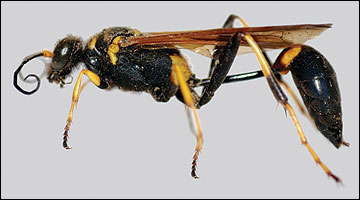 Figure 9
Figure 9
Mud dauber wasp; about 1 inch long.
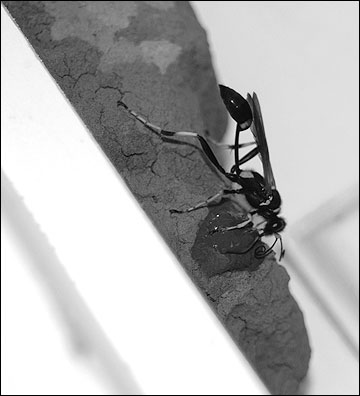 Figure 10
Figure 10
Mud dauber nest.
Cicada killer wasps
The cicada killer wasp (Sphecius speciosus) is 1.5 to 2.0 inches long and brownish-black with yellow markings on the abdomen and face (Figure 11). Although their size is intimidating, cicada killers are not aggressive and will sting humans only if pinned against the skin.
The female digs a burrow in the soil, captures cicadas by stinging and paralyzing them, and then carries them into the burrow. An egg is deposited on each cicada and a cell is closed off. Cicada killer wasps produce one generation per year. The larvae spend the winter in the nest cell in the soil.
The only damage these wasps cause is the unsightly dirt piles dug out to create nests. The piles usually disappear with the first rain. Because cicada killers are beneficial, control efforts are not recommended. If you feel control is necessary, either apply liquid wasp spray or place a tablespoon of insecticide dust into the burrow opening.
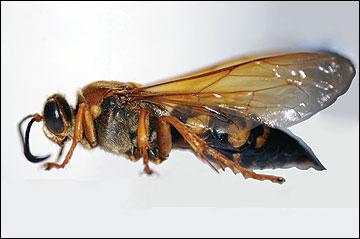 Figure 11
Figure 11
Cicada killer wasp; about 1.75 inch long.
Bee and wasp management
Apply chemicals only where needed. Make yourself aware of potential side effects to pesticide exposure. Before using any pesticide, please read the label carefully for directions on application procedures, appropriate rate, first aid, storage and disposal. Make sure that the chemical is properly registered for use on the intended pest and follow all label directions. Keep insecticides in original containers, complete with labels, and keep them out of the reach of children and pets. Do not allow children or pets near treated areas before these areas dry. Carefully and properly dispose of unused portions of diluted sprays and empty insecticide containers.